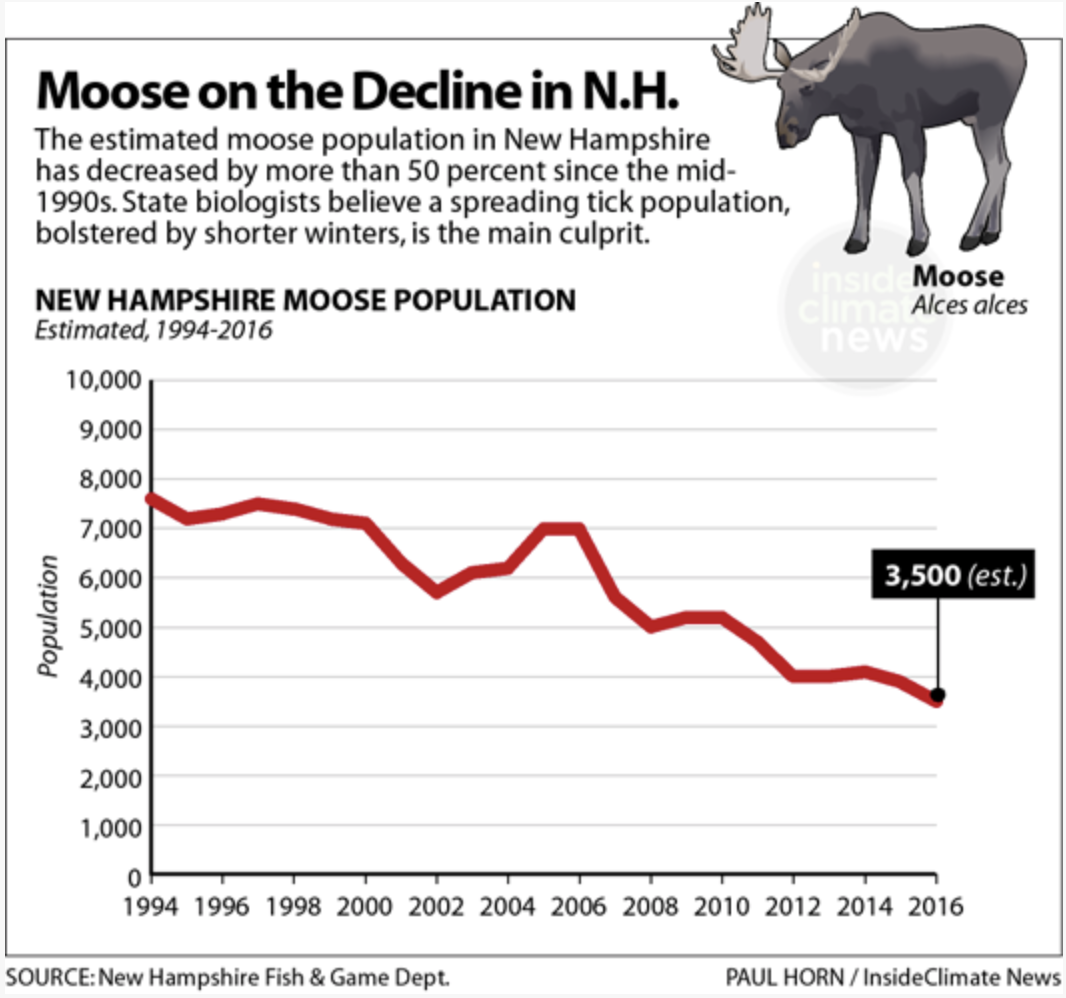Are Moose Populations in the United States on the Decline?
Author: Katelyn Fournier, Edited By: Emilyann Ashford
In the United States moose populations are suffering as temperatures get warmer causing heat stress and pathogens to become more redundant among populations.
Figure 1: Adult American Moose walking in the woods.
Gray and Brown Moose Standing on Brown Tree Branches by PickPik
The American Moose
According to the Alaska Fish and Game Department, the American Moose (Alces americanus) is the largest member of the deer family. A few distinctive characteristics that separate Moose from other members of the family, which include flattened antlers, long legs, wide hooves, and tubular hairs (1). Each characteristic having its own distinct advantage. Large flattened antlers, long legs and wide hooves all serve as defense from large predators common in their environment such as bears and wolves. Long legs and wide hooves also serve as an aid to their dispersal ability in deep snowfall being very common to their natural habitat. The Tubular hairs that Moose have allow air to be trapped inside the coat of the animal and provide insulation, which is a large reason moose can withstand colder climates more naturally than warmer climates. Currently, moose inhabit 19 of the 50 United States.
Present Status Of Moose
Moose are considered keystone species and hold a high ecological importance. Their “job” is to eat aquatic and terrestrial plants to keep populations under control. Moose also act as food sources for other predators like bears and wolves. Understanding how climate change impacts moose is not only important to their species but to other species and ecosystems as a whole.
Recently there has been a decline in moose populations, as shown in Figures 3 and 4.
Figure 3: Decline of moose populations in New Hampshire from 1994-2016. Moose on the Decline in N.H. by New Hampshire Fish & Game Department
Figure 4: Decline in moose populations in Michigan from 1960-2005. Moose Population, 1960-2005 by Massachusetts Department of Education
In both graphs starting in 1995 there was a sharp decrease in populations, then a sudden rise of populations around 2005, then another sharp decrease. According to the National Oceanic and Atmospheric Administration (NOAA) the year 2005 in the United States was recorded as an above average temperature year, so the overall climate was warmer. The sudden spike in 2005, shown in both graphs, is seemingly not temperature related and most likely random. But the sharp decrease after 2005 is most likely climate related as the next years recorded temperatures are also above average.
Reasons For Decline
Induced Heat Stress
A study conducted in Minnesota sought out to explore the potential harm to moose populations with increasing temperatures due to climate change (3). Researchers saw that moose increase their oxygen consumption and respiration rates when temperatures reach above 57°F to reduce body heat through evaporative cooling (3). Evaporative cooling is a method many mammals use to cool down. When water evaporates from the surface of a mammal those surfaces become cooled and trigger dilated blood vessels to circulate cooled blood though the mammals body. In moose, evaporative cooling is a physiological sign of heat stress (3). When a moose experiences heat stress it is expected that their respiration and heart rates will increase, they will seek shade, cool winds and water, and they will bed down, eventually stopping food foraging (6). Moose that don’t gain weight during warm summer months before the fall may not have enough body fat to survive in the winter months (6).
Due to the built in insulation system that moose have, as mentioned above, they reside in colder climates because their hairs allow for heat insulation. When moose are in warmer climates those hairs are trapping in warmer air dramatically increasing their body temperatures on top of the additional body heat they have due to a warmer climate. This puts them at additional risk for heat stress.
Increase In Pathogen Load
Another cause of moose population declines are pathogens like brain worm and ticks that become more prevalent as temperatures get warmer (5). Ticks thrive in weather that is warm and snow free because it allows them time to search for a host when the cold won’t kill them. “Moose ticks” then take the opportunity to latch on to moose by the thousands, eventually draining its blood thus killing the moose (4). A second pathogen, brain worm, happens when moose accidently eats an infected gastropod. Consumption allows the larvae of brain worm to penetrate the moose’s stomach wall and travel to its nerves until it reaches the spinal cord and brain where the larvae grow and reproduce (5). Brain worm most commonly affects white-tailed deer. As white-tailed deer move north into moose territory due to warming temperatures they can inadvertently pass brain worm to moose. Animals infected with these pathogens can have more elevated body temperatures which may cause them to be more susceptible to heat stress (3).
What Can Be Done?
Conservation strategies to help moose populations are still being explored as the full effect of climate change on them needs to be studied further. Conservationists are suggesting starting with decreasing the rising temperatures associated with climate change. Cutting out hot temperatures could decrease heat stress and abundance in pathogens.
A good way you can contribute to decreasing global temperatures associated with climate change is by decreasing your carbon footprint or the amount of carbon dioxide you produce. Easy ways to reduce your carbon footprint include eating less meat, driving less, turning off and unplugging electronics when you are not using them, and reducing the overall amount of waste you produce.
Citations:
1. Bradford, A. (2014, November 14). Moose: Facts About the Largest Deer. Retrieved March 20, 2020, from https://www.livescience.com/27408-moose.html
2. Mccann, N., Moen, R., & Harris, T. (2013). Warm-season heat stress in moose (Alces alces). Canadian Journal of Zoology, 91(12), 893-898. doi: 10.1139/cjz-2013-0175
3. Rines, K. (2014). New Hampshire Moose Study Roundup. New Hampshire Wildlife Journal, 2-4.
4. New York State Department of Environmental Conservation. (n.d.). Brain Worm. Retrieved March 21, 2020, from https://www.dec.ny.gov/animals/72211.html
5. Schwartx, C.C., Renecker, L.A., Nutrition and energetics. In ecology and Management of the North American moose. Edited by, Franzmann, A.W., Schwartz, C.C., Smithsonian Institution, Washington, D.C pp. 441-487
6. National Temperature and Precipitation Maps. (n.d.). Retrieved April 23, 2020, from



